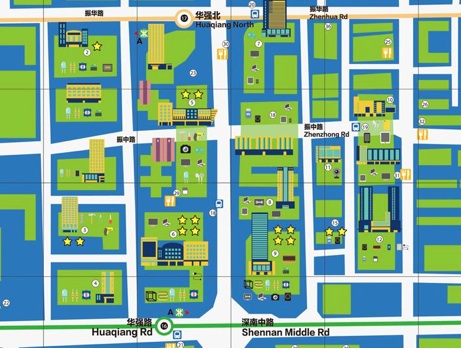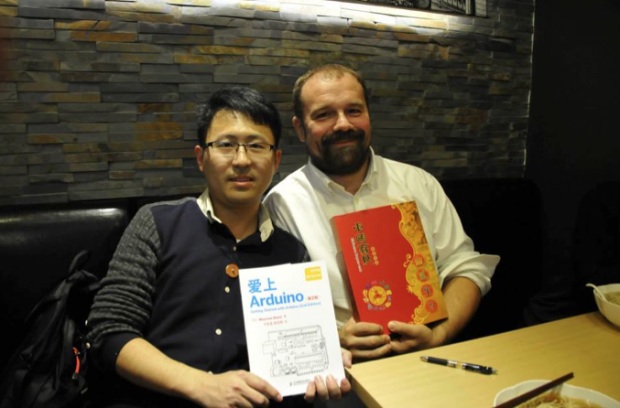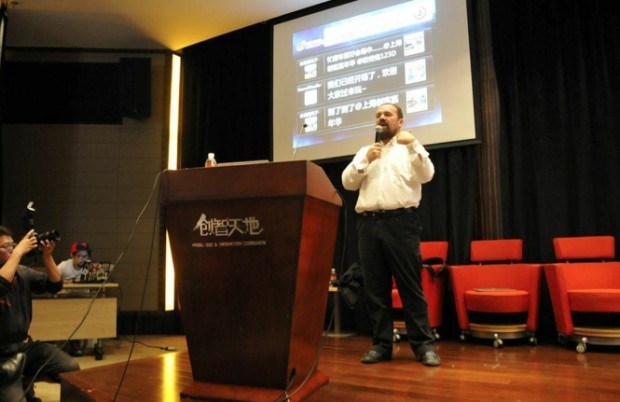
(originally posted on Makezine)
Right after the overwhelming experience of Maker Faire Rome I left Europe for a week a quick tour in China. There are a lot of cool things happening there. I’d been to China twice before for a very short time so this time I wanted to spend a few days to meet with people and take part in some cool events going on in Shanghai and Shenzhen. I accepted an invitation to give a talk about Arduino at the School of Design of Hong Kong Polytechnic University and while I was there, William Liang (adjunt assistant professor at the same university) took me to visit the local community at the Dim Sum Lab hackerspace.
Dim sum is a delicious, Hong Kong speciality composed of a myriad of different, bite-sized delights. Similarly, the DimSum Lab hosts different types of communities with various interests, from coders to makers.
I then flew to Shenzhen to meet with the people at SeedStudio who took me around the city to discover the different opportunities this city offers. Makers are closer to the manufacturers here and have easier access to new components and parts. Clearly there is an advantage and certain makers, if they get organized, can jump quickly from a small idea to large scale manufacturing for a much lower cost.
This happens because they are not only close to manufacturers, but closer to the supply chain as 90 percent of electronic parts are made in China and you can basically assemble a device very quickly because of easy access to parts. Recently, Seeds Studio published the Maker Map of Shenzhen which looks a bit like the celeb’s house map you get in Los Angeles, but instead of getting information on where famous actors live, you can easily find out where suppliers, manufacturers and hackerspaces are.

There are also lots of projects based on Arduino. We realized more than 90 percent of the boards people use are fake, not even Arduino clones, but fakes. We discussed this topic with SeedStudio which has always been very respectful of the Arduino project and of the use of our trademark. It’s understandable, in a way, that an Arduino made in Europe tends to be quite expensive for most of the people in China. We know that the interest in Arduino is very high and we are working on how to provide official Arduino boards in China.
As we often said, it’s not only about making boards and selling them. It’s about creating all the official documentation in Chinese, having an official forum and social media presence, and making videos and sharing them outside of YouTube (inaccessible for many Chinese people). We clearly need to change the way we do things to be able to interact with the Chinese community. It’s going to take a bit than just focusing on providing accessible boards.

Later, when we visited the local hackerspace in Shenzhen called Chaihuo, some of the people I met there had just come back from Maker Faire Rome. They showed me all the pictures they took and it was amazing how they reported back to their peers the experiences they had in Italy and the projects they discovered during the event. During the Q&A session we had, they asked me a lot of really detailed questions and Eric Pan, from Seeds Studio, did a great job in translating my answers.
Next stop was Shanghai where I gave a talk at the Sino-Finnish Centre at College of Design and Innovation at Tongji University. I visited the community of the XinCheJian hackerspace and then participated in HackedMatter, a whole day focused on rethinking manufacturing from the point of view of science fiction narratives and exploring “how the professionalizing of maker culture is developing increasingly intimate relations with the small-scale factory owners and micro-entrepreneurs that make up China’s core of hardware manufacturing”. The event was organized by Silvia Lindter in conjunction with the Shanghai Maker Carnival.

During Hacked Matter I gave a talk on the topic of collaboration, a concept at the heart of the Arduino approach, highlighting the idea that innovation is not purely about technology, but more on creating the right collaborations with the right people.
It was interesting to note that the maker community in Shanghai is pretty diverse and composed not only by locals as there are a lot of people coming originally from outside China who moved there. At the Maker Carnival I discovered many high quality projects and realized some differences with the community in Shenzhen. It was also interesting to understand how Chinese culture works and how Arduino can create channels to communicate within that culture.
Open hardware companies from around the world could clearly benefit from a trip to China especially if they can find someone local to work with, tapping into the local community to go beyond language barriers. There’s a lot of very talented people over there able to deal with complicated projects. At the various hackerspaces I visited I received interesting questions and I was lucky enough to have someone translating otherwise I’d never met these smart people.








